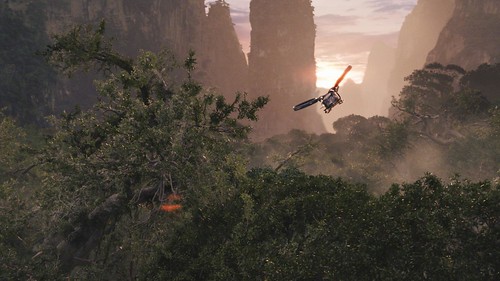'Avatar' is Real, says Tribal People
Director James Cameron received his Golden Globes awards for ‘Avatar’ last Sunday, and revealed one of the central ideas of the film.
"Avatar asks us to see that everything is connected,” he said in his acceptance speech, "All human beings to each other, and us to the earth.”

Avatar Copyright 20th century Fox
The film ‘Avatar’ is a fantasy, a dream set in the future on a far-away imaginary moon inhabited by a blue-skinned, feline-eared tribe, the Na’vi people. They live deeply connected ancient homeland: a fertile forest of giant palms, floating mountains and luminous moss.
The future of the forest and the survival of its people are threatened by aggressive invaders seeking to profit from the mineral deposits that lie underground. For the prospectors, the indigenous tribe is nothing but a nuisance: the people are ‘savages’ who are ‘threatening the operation’; they are ‘hostiles’ who have the audacity to defend their lives and their lands with arrows tipped with poison. They must move from their home to make way for bulldozers. And if they resist, the invaders will ‘hammer them hard’.
The film is a beautiful but tragic vision of an ecologically-enlightened people facing the decimation of their community and their ancestral lands. They are just days away from being gas-bombed and machine-gunned by greedy, ruthless imperialists armed with giant soldier-robots. It is not real.
Except it is. In many ways, it is all too real. For the fundamental story of Avatar - if you take away the multi-coloured lemurs, the long-trunked horses and warring androids - is being played out time and time again, on our planet and in our age.
From the rainforests of the Amazon to the frozen taiga of Siberia and the snow peaks of Colombia, the world’s last-remaining tribal peoples – who, for many generations have followed ways of life that are largely self-sufficient, and are clearly different from the mainstream and dominant society - are at risk of extinction. Like the Na'vi, they are being hounded from the lands on which they depend entirely for their survival, and on which they have lived successfully for thousands of years. Their lands are appropriated for colonization, logging, mining, oil exploration and any other number of avaricious motives. Like the Na’vi, tribal peoples are rarely consulted, frequently evicted and, at worst, massacred by powerful forces who find their tenure of the land an inconvenience.
And when they have been displaced from their lands, or when their lands have been destroyed, so follows the catastrophic disintegration of a people. “Next to shooting indigenous peoples, the surest way to kill us is to separate us from our part of the Earth”, says Hayden Burgess, a Native American. Just as the Na’vi describe the forest of Pandora as ‘their everything’, for most tribal peoples, life and land have always been inextricably connected. The Earth is the bedrock of their existence - the provider of food and shelter, the burial ground of their ancestors and the spiritual focus of their lives. Importantly, it is also the inheritance of their children. “We Indians are like plants” says a Guarani Indian from Brazil. “How can we live without our soil, without our land?”
Tribal peoples are also discriminated against by a world that believes them to be backward, primitive or ‘uncivilised’ because many choose to live differently, have no formal education or do not aspire to the materialism of the industrialized world. An outdated conceit, of course, that has at its core the belief that there is only one way of living life successfully: one that asserts that only certain societies have progressed. What such racist ideology does foster, however, is a convenient justification for violence, theft and abominable abuses of human rights. “When people are sitting on something that you want,” says Norm in ‘Avatar,’ “you make them your enemy. Then you can justify it.”
However, we destroy tribal peoples at our peril. Many still have a holistic view of nature and see man as part of, not separate from, the earth. Nature is a intrinsic, not merely utilitarian value; it is not just a commodity to be exploited for commercial expansion. And for nature to endure, a sustainable attitude to its caretaking is essential. “We are not here for ourselves,” said Gana Bushman, Roy Sesana. “We are here for our children and the children of our grandchildren.” These sentiments are echoed in the words of Avatar’s shaman, Moan, when she says, “This is our land, for our children’s children.”
Such ideas are clearly far from being ‘backward’ or ‘uncivilised’. At a time of ecological crises - while the Arctic melts, the seas rise, the rainforests burn and the climate warms - it doesn’t make sense to disregard the wisdom of those whose long-term approach to the natural world has been informed by knowledge over millennia.
But as fragile ecosystems are damaged, so the peoples with a detailed understanding of them are also threatened, such as the Jarawa, who are thought to have lived in the Andaman Islands for up to 60,000 years, and who now inhabit the islands' last remaining tracts of virgin rainforest. One of the best ways of protecting these eco-systems must surely be to secure the land rights of their indigenous communities. ‘We are the ones who ensure the conservation of the forests on our land in accordance with the way we have always managed them. We are the ones who live in the forest and we are the ones who look after it,’ said the Paraguyan Ayoreo-Totobiegosode people in a recent letter to the country's government.
“Help us,” says Moan in ‘Avatar’, as giant bulldozers rip through her home and fires engulf her forest. In the film, however, the ending is a hopeful one: the invaders are sent packing. Across the ‘real’ world, tribes are still bullied; still at risk of extinction. And when they die, so thousands of years of botanical knowledge, ancient languages, inventive skills, human-scale values and imaginative ways of seeing the world - the diversity of human life - die with them.

Avatar copyright 20th Century Fox
All information contained herein from Survival International. For more information, please see http://www.survivalinternational.org



















